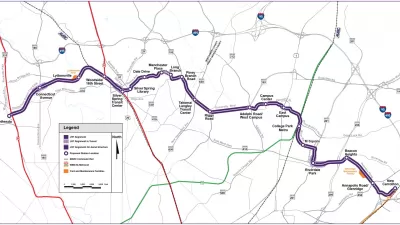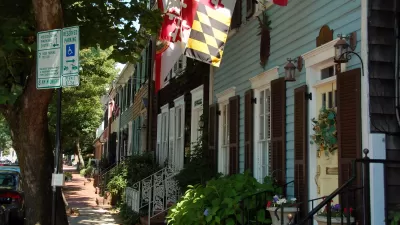The Southern Maryland Rapid Transit Project could take thousands of cars off the road and ease congestion in one of the country's busiest corridors.

With the nation's highest per capita number of road fatalities and the country's costliest commute, Southern Maryland is proposing to alleviate traffic with a light rail project, reports Alex Holt. The 18.7-mile-long Southern Maryland Rapid Transit Project (SMRT) would include 13 stations and give D.C.-area commuters an alternative to personal vehicles.
The state has kicked around the idea since the 1990s without much progress, but as area traffic only gets worse as the population increases, SMRT could pick up more support. This January, state legislators introduced bills proposing to allocate $12 million and $15 million in the 2022 and 2023 budgets for the necessary environmental review that would move the SMRT project forward. Prince George County, which would host eight of the line's stops, has been a staunch supporter of the project, as has the Maryland Transit Caucus.
Governor Larry Hogan, however, has leaned heavily in favor of road projects, writes Alex Holt. Hogan supports doubling the number of lanes on the Harry Nice Bridge, a move that transportation experts say will only increase traffic through the area. SMRT supporters continue to push the project forward. "It's not just about transportation," said Delegate Debra Davis, who introduced one of the January bills. Light rail has the potential to promote economic development and improve public health and quality of life for Maryland residents.
FULL STORY: A proposed light rail for Southern Maryland aims to relieve some of America’s worst traffic

Planetizen Federal Action Tracker
A weekly monitor of how Trump’s orders and actions are impacting planners and planning in America.

San Francisco's School District Spent $105M To Build Affordable Housing for Teachers — And That's Just the Beginning
SFUSD joins a growing list of school districts using their land holdings to address housing affordability challenges faced by their own employees.

The Tiny, Adorable $7,000 Car Turning Japan Onto EVs
The single seat Mibot charges from a regular plug as quickly as an iPad, and is about half the price of an average EV.

Toronto Condo Sales Drop 75%
In two of Canada’s most expensive cities, more condos were built than ever — and sales are plummeting.

Vehicle-related Deaths Drop 29% in Richmond, VA
The seventh year of the city's Vision Zero strategy also cut the number of people killed in alcohol-related crashes by half.

Seattle's Plan for Adopting Driverless Cars
Equity, safety, accessibility and affordability are front of mind as the city prepares for robotaxis and other autonomous vehicles.
Urban Design for Planners 1: Software Tools
This six-course series explores essential urban design concepts using open source software and equips planners with the tools they need to participate fully in the urban design process.
Planning for Universal Design
Learn the tools for implementing Universal Design in planning regulations.
Smith Gee Studio
City of Charlotte
City of Camden Redevelopment Agency
City of Astoria
Transportation Research & Education Center (TREC) at Portland State University
US High Speed Rail Association
City of Camden Redevelopment Agency
Municipality of Princeton (NJ)





























